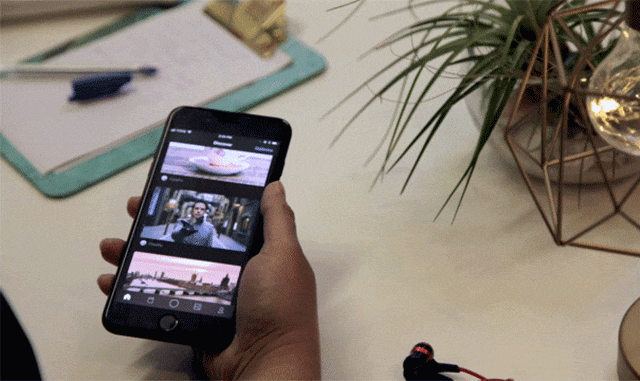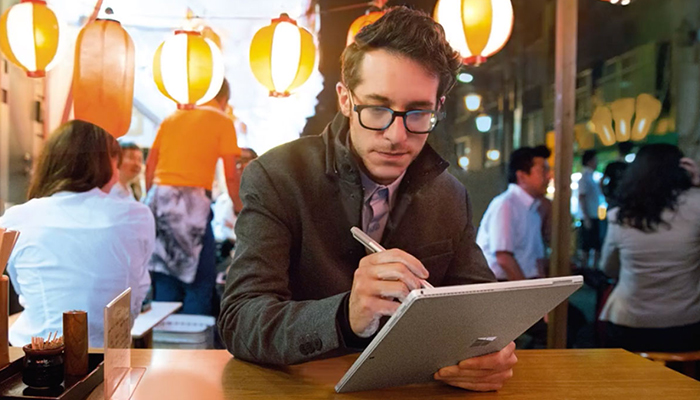The term cinemagraph was first introduced by fashion photographer Jamie Beck and motion graphic designer Kevin Burg, who used it to animate their fashion photography. With its first use only in 2011, cinemagraphs are still a relatively new technology.
Cinemagraph is a portmanteau of the words “Cinema”, meaning moving image and “Photograph”, meaning still image.

What are Cinemagraphs? | Flixel
A cinemagraph can be described as a still photograph, which contains a small amount of isolated, repetitive movement. Think of them as a hybrid between an image and a video – it is like an image in the sense that it is predominantly still and has one moving element that plays like a small video on loop.
The most common cinemagraph formats include the standard GIF, as well as video formats such as MP4 and MOV.
The Big Brands Use Cinemagraphs
Some of the biggest companies in the world are now using cinemagraphs. They are being used on websites, banner ads, social media accounts and email campaigns.
Some of the worlds big companies that use cinemagraphs include: IKEA, Coca Cola, Disney and Prada.
Cinemagraphs are not limited to big business, they can also be used to advertise new tv shows, such as how Canal+ used them to advertise the new release of Versailles.

Versailles Advertisement Campaign | Canal+
Cinemagraphs offer a more immersive experience for the user and therefore can be used as part of a digital toolkit for brands. Due to the introduction of movement, we can use cinemagraphs to tell stories and offer users a flavour of a brand’s artistic expression.
From a business perspective, using cinemagraphs is a great way to let your clients know that you are a forward-thinking and contemporary company that is bang up to date with the latest digital marketing techniques. It is a way to stay ahead of the curve and get a competitive advantage over your business rivals.
When used properly, a cinemagraph can be used to add elegance to your brand. A cinemagraph can gracefully capture a shine, glimmer or sparkle more effectively than a static image.
Cost Effective Alternative To Videos
We are more and more accustomed to seeing video content when we browse online. Whether it being full screen background videos on a splash page of a website or auto playing adverts on social media, there is no doubt that video is a key medium for encouraging users to interact with your content online.

Cost Effective Alternative To Videos | Flixel
However, the main drawback with video production is the amount of time it takes to produce and the additional cost that they quite often require to develop.
With cinemagraphs however, because the video element is only a small loop, production time and costs can be greatly reduced. This point stands even stronger when you consider that the vast majority of cinemagraphs do not require sound and therefore the additional cost for this medium can be discounted.
Cinemagraphs Are Ideal For Social Media
Have you ever heard the expression “Content is king”, well that is more true now than ever before, in particular video content.

Social Media Campaign | Mercedes Benz
Video is now ideal for sharing on social media. It now auto plays and auto loops across the main social media platforms such as Facebook, Twitter and Instagram. In addition, the social reach of cinemagraphs can be expanded further into the world of Pinterest with the launch of the new cinematic pin feature. Furthermore, the auto-play feature makes cinemagraphs easy to consume and arguably more importantly, hard to ignore.
Video marketing is now migrating towards short and concise video content that customers can quickly and easily digest. As a result of this content being readily available, video marketing in the form of cinemagraphs have never been so accessible for businesses of all sizes.
Cinemagraphs Tell Stories

Cinemagraphs Tell Stories | Flixel
One key advantage of using Cinemagraphs over conventional static imagery is that they isolate movement of a specific area of the image. By drawing the user’s attention in this way, it allows us to put the focus on a particular action that is associated with a brand or product. It also allows a story to be told that allows the user to have a greater understanding of the product or service in question.
For instance, when advertising food, viewing the dripping of the maple syrup in video format brings the user closer to the product. We can experience a tangible emotional sense of the taste, smell and texture of the syrup, which would not be as effective with a still image.
Cinemagraphs are at their most powerful when they are able to capture a simple, short and subtle action. A lot understanding can be gained by the user from a small moment in time.
The other benefit of a cinemagraph is that it has the immediacy of a video as it plays on load and can grab the attention of the user straightaway. The drawback of a video is that they often require a click to start button, however with cinemagraphs, this initial step is removed and the user can engage with the content more freely.
Cinemagraphs Drive Engagement
Cinemagraphs offer more visual stimulation than a static image and therefore capture the attention of the user more easily. A 2016 campaign by Microsoft found that cinemagraph based adverts on Twitter had an increase of 110% in engagement rate compared to still images. Similarly on Facebook, the cinemagraph adverts had a 85% increase of engagement compared with static images.
In terms of costs, the research that Microsoft undertook highlighted a 45% decrease in the cost per click on a cinemagraph, when compared to static images.
“The engagement rates were through the roof and it shows how more brands can benefit from adopting this new medium” – Linda Chep, General Marketing Manager at Microsoft.

2016 Campaign Results | Microsoft
The increase of engagement is not limited to social media. A report conducted by Experian found that 72% of email marketers reported an increase of engagement when adding cinemagraphs or gifs to their email campaigns when compared to static images.
As a result of this, the engagement levels increase dramatically as the user is drawn in by the cinemagraph and are far more likely to click to read more. Therefore, it proves that cinemagraphs are a highly powerful tool that guarantees an increase in conversions and therefore changes the way we think about digital marketing.
Conclusion
With a steadfast and creative community making strides forward, the levels of innovation in the cinemagraph environment will only improve and refine as time passes.
With such an upward trajectory set to continue on into the future, it is a great opportunity for businesses of all sizes to harness the full potential of benefits that cinemagraphs can bring.